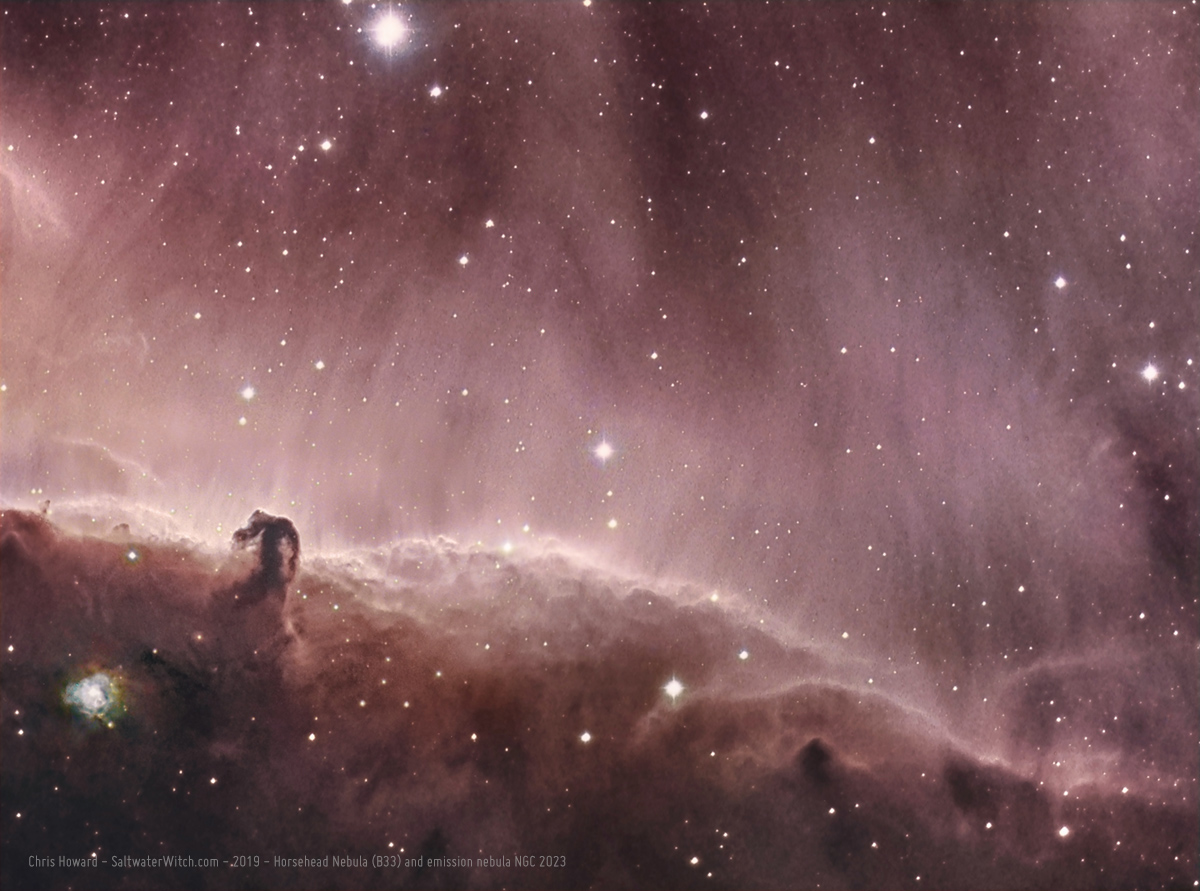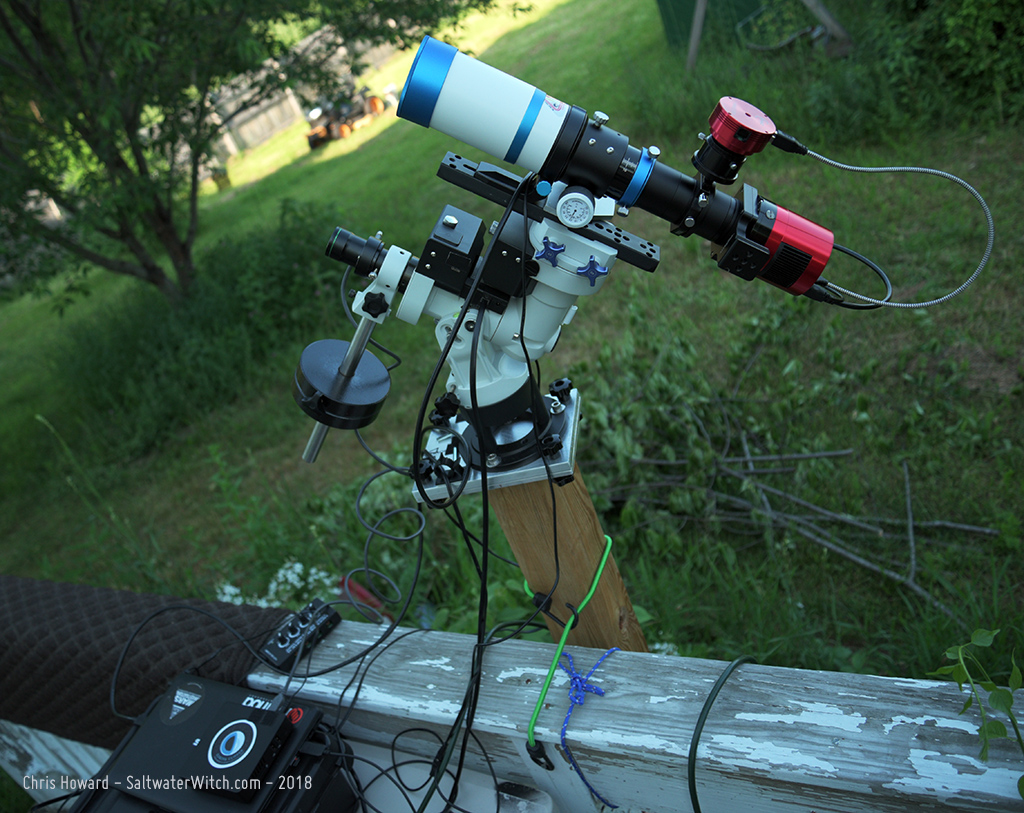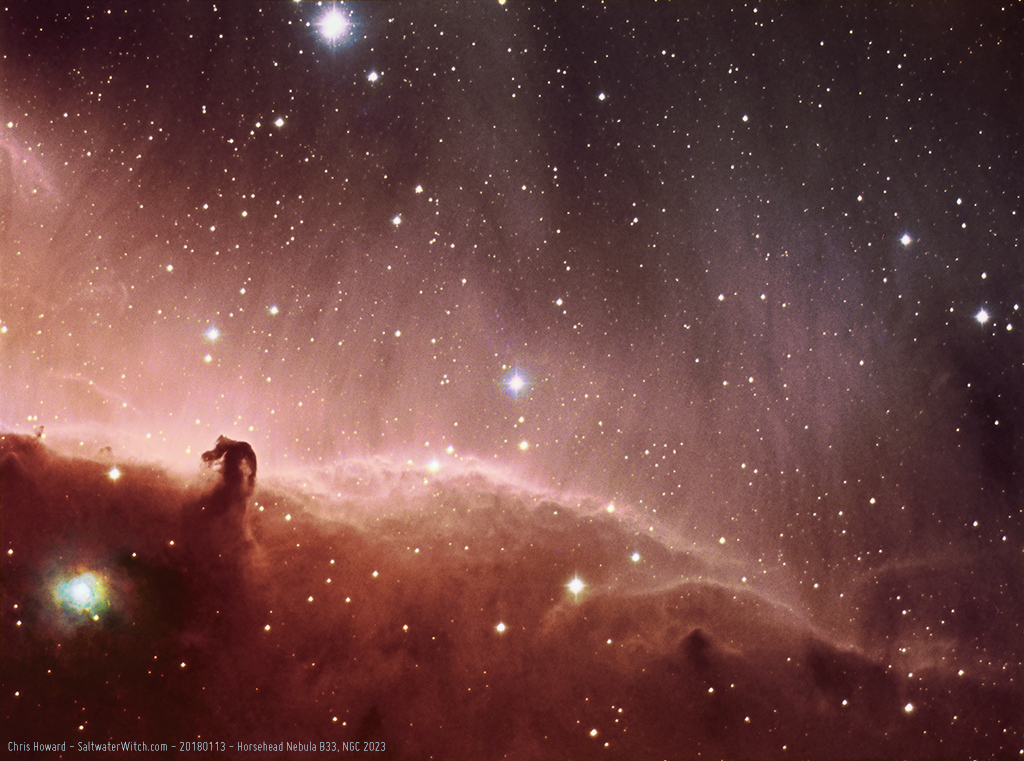Horsehead Nebula (B33) and NGC 2023
The Horsehead Nebula (B33) and the emission/reflection nebula NGC 2023 (below and left of the Horsehead) in the constellation Orion. With this field of view, you're looking at around 1.7 trillion miles from one side to the other. I captured a batch of narrowband data in Orion last year. Today, I reprocessed some of it, playing with contrast and color balance.

Posted June 1, 2019
Astro Session: June 8, 2018
 How about a little Voldemort with your Astronomy? Here's Barnard 104, the Fish Hook Nebula (backward checkmark nebula was already taken?), just left of the star beta Scuti in the constellation Scutum--along with several other absorption nebulae in the Barnard Catalogue, 113, 111, 110, 107, and B106. (See the image below). These are the dark cloudy regions across the middle, which stand out against the glow of a billion stars in this area of the Milky Way Galaxy. (Okay, I'm being a bit deceptive with the drama there. It's probably more like 5 or 10 billion). Oh, and let's not forget NGC 6704, the open star cluster toward the bottom in the center. A note on the "Barnard Catalogue", which is what I've always called it: I just found out the official name for it is the very Harry Potter sounding, Barnard Catalogue of Dark Markings in the Sky. Go home, Death Eaters! The star gazing geeks got here first! (ZWO ASI071MC cooled CMOS camera at -10°C, iOptron CEM25P EQ mount, William Optics ZenithStar 61 f/5.9, 12 x 120 sec. sub exposures, stacked in DSS. Location: Stratham, New Hampshire, US. Bortle 4).
How about a little Voldemort with your Astronomy? Here's Barnard 104, the Fish Hook Nebula (backward checkmark nebula was already taken?), just left of the star beta Scuti in the constellation Scutum--along with several other absorption nebulae in the Barnard Catalogue, 113, 111, 110, 107, and B106. (See the image below). These are the dark cloudy regions across the middle, which stand out against the glow of a billion stars in this area of the Milky Way Galaxy. (Okay, I'm being a bit deceptive with the drama there. It's probably more like 5 or 10 billion). Oh, and let's not forget NGC 6704, the open star cluster toward the bottom in the center. A note on the "Barnard Catalogue", which is what I've always called it: I just found out the official name for it is the very Harry Potter sounding, Barnard Catalogue of Dark Markings in the Sky. Go home, Death Eaters! The star gazing geeks got here first! (ZWO ASI071MC cooled CMOS camera at -10°C, iOptron CEM25P EQ mount, William Optics ZenithStar 61 f/5.9, 12 x 120 sec. sub exposures, stacked in DSS. Location: Stratham, New Hampshire, US. Bortle 4).

So, all in all, a successful night of astronomy stuff, even with the clouds rolling in around 2 am. Here are a couple more wide-field shots from the session, the Eagle Nebula and the Sadr Region--the diffuse nebula (IC 1318) around gamma Cygni, also called Sadr (center star in the constellation Cygnus).


 I spent a few hours last night dialing in the Orion "TOAG" or Thin Off-Axis Guider, which I bought a couple years ago, but have never been able to get working properly. I've tried seven or eight times, added it to my imaging train a couple times a year, attempting to get things working without success. Well, I went at it again last night, and you know what? It came together. I still have some weirdness to tinker with--to work out, but for the first time I wasn't guiding with a separate scope. I was guiding at the same focal length as the ZS61 using a pick-off prism that directs a portion of the field of view up into the guide camera. Here's the setup I used last night to dial-in the distance between the primary camera and guide camera, and then bring everything into focus. I ended up with some pretty cool shots, but my main purpose was to get Off-Axis Guiding (OAG) adjusted and working--and that was with me slewing around the sky to clear areas between banks of clouds to find some halfway interesting targets. In this setup I'm using my trusty ZWO ASI120MM-S for guiding, and the ZWO ASI071MC cooled color camera for the primary. The goal here is to be able to guide (track the motion of the earth against the star field to a very fine degree, and make small incremental adjustments to the EQ mount) so that I can take long exposures without worrying about the external guidescope issues I know all of you care deeply about, like field rotation and differential motion between a guide scope and imaging telescope. I have been able to take 20 minute exposures with a guidescope and camera, but the stars are not as sharp as I would like--think pressing down the button of your camera and holding the shutter open for 20 or 30 minutes and have everything in the field of view remain in sharp focus. That's essentially what the guiding system accomplishes, taking continuous images of the stars and feeding them to some pretty sophisticated software that controls the motion of the equatorial mount (that's the white z-shaped device with the black boxes on which the telescope is fastened and balanced).
I spent a few hours last night dialing in the Orion "TOAG" or Thin Off-Axis Guider, which I bought a couple years ago, but have never been able to get working properly. I've tried seven or eight times, added it to my imaging train a couple times a year, attempting to get things working without success. Well, I went at it again last night, and you know what? It came together. I still have some weirdness to tinker with--to work out, but for the first time I wasn't guiding with a separate scope. I was guiding at the same focal length as the ZS61 using a pick-off prism that directs a portion of the field of view up into the guide camera. Here's the setup I used last night to dial-in the distance between the primary camera and guide camera, and then bring everything into focus. I ended up with some pretty cool shots, but my main purpose was to get Off-Axis Guiding (OAG) adjusted and working--and that was with me slewing around the sky to clear areas between banks of clouds to find some halfway interesting targets. In this setup I'm using my trusty ZWO ASI120MM-S for guiding, and the ZWO ASI071MC cooled color camera for the primary. The goal here is to be able to guide (track the motion of the earth against the star field to a very fine degree, and make small incremental adjustments to the EQ mount) so that I can take long exposures without worrying about the external guidescope issues I know all of you care deeply about, like field rotation and differential motion between a guide scope and imaging telescope. I have been able to take 20 minute exposures with a guidescope and camera, but the stars are not as sharp as I would like--think pressing down the button of your camera and holding the shutter open for 20 or 30 minutes and have everything in the field of view remain in sharp focus. That's essentially what the guiding system accomplishes, taking continuous images of the stars and feeding them to some pretty sophisticated software that controls the motion of the equatorial mount (that's the white z-shaped device with the black boxes on which the telescope is fastened and balanced).
Posted June 8, 2018
Astro Session - January 13, 2018
It's winter and that's when Orion is arguably the main attraction in northern hemisphere skies. HaRGB of the Horsehead Nebula (Barnard 33) along with the reflection nebula NGC 2023 (below and left), part of a whole neighborhood of nebulosity around the leftmost star in Orion's Belt, the blue supergiant Alnitak. (I kept Alnitak out of frame, but it would off to the left with a wider field of view). The Horsehead is an absorption (or dark) nebula about 1500 lightyears from Earth, and shows up so prominently because it's blocking most of the starlight behind it. (10 x 600 second Ha frames, 10 x 240 second RGB frames, 24 dark cal frames taken with an Atik414Ex mono CCD, William Optics GT-81 + 0.8x Field Flattener/Reducer f/4.7, iOptron CEM25P EQ mount, Astronomik 12nm Ha filter, Baader RGB filters, WO 50mm guide scope with ZWO ASI120S-MM guide cam, INDI/KStars/Ekos observatory control. Location: Stratham, New Hampshire, US. ~Bortle 4)

The full FOV for this shot:

